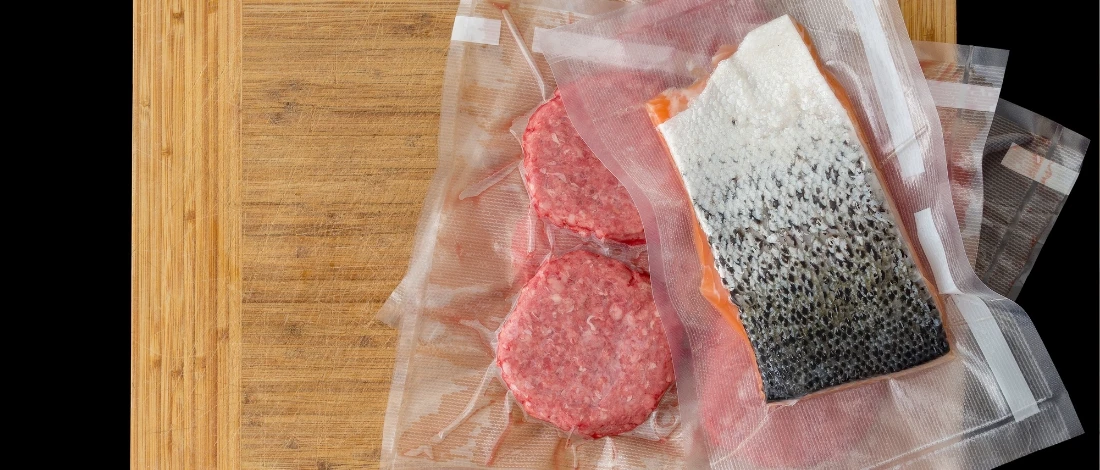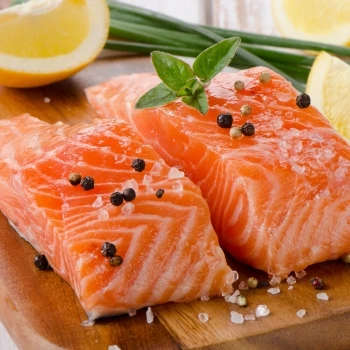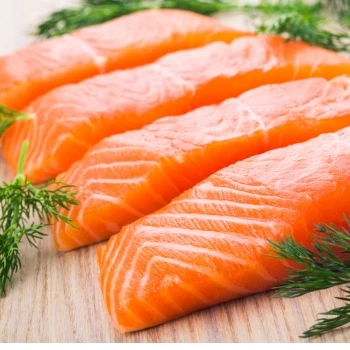
My extensive experience in the science of nutrition and wellness has allowed me to uncover the intricate relationship between the foods we consume and the vitality we seek.
From the vibrant hues of salmon to the textures of grass-fed beef, I’ve delved into the nuances of each option, dissecting their nutritional profiles and examining their impact on the human body.
Here is what I have learned.
Quick Summary
- Salmon is a fatty fish full of omega-3 fatty acids, while beef is red meat that provides essential amino acids and vitamins.
- It offers about 570 IU of Vitamin D, 5mcg of Vitamin B12, and 30mcg of Selenium, whereas beef provides minimal Vitamin D, about 2mcg of Vitamin B12, and around 23mcg of Selenium.
- Salmon’s omega-3 fatty acids contribute to heart maintenance and reduce inflammation, while beef’s iron aids in various bodily functions.
- High levels of vitamin D and omega-3s in salmon promote bone health and immune function, while beef’s rich zinc content supports immune health and wound healing.
Nutrition

Salmon: The Fatty Fish Marvel
Salmon is a white meat despite the pink color of its flesh, and despite the fact that many people don’t consider fish to be meat. Eating this seafood is known to be good for you. It has all the building blocks you need to build your body without much fat or cholesterol.
Rich in omega-3 fatty acids, salmon boasts a treasure trove of healthy fats that contribute to a healthy heart, brain function, and reducing inflammation. A 3.5-ounce (100g) serving of salmon delivers a hefty dose of omega-3 fatty acids, around 1.8g, offering an excellent source to meet your nutritional needs.
Furthermore, salmon is a great fish source of high-quality protein for a healthy diet, with approximately 20g eaten per serving.
Eating salmon provides high levels of essential vitamins and minerals, including vitamin B12, vitamin D, and selenium, offering a well-rounded nutrient profile to support overall health.
Salmon’s nutritional profile for a 3.5 oz serving is:
- Calories: 142
- Total Carbohydrates: 0g
- Protein: 19.8g
- Fat: 6.3g
- Fiber: 0g
- Net Carbs: 0g
- Vitamin C: 0mg
- Vitamin E: 0.11mg
- Vitamin D: 0.86mg
- Linoleic Acid: 1.6mg
- Vitamin B6: 0.82mg
- Sodium: 117mg
- Potassium: 490mg
- Phosphorus: 200mg
- Niacin (Vitamin B3): 7.86mg
- Vitamin K: 0.08mcg
- Calcium: 12mg
- Riboflavin (Vitamin B2): 0.38mg
- Iodine: 60mcg
- Iron: 0.8mg
Beef: The Protein Powerhouse
On the opposite end of the spectrum, beef from cattle has even more protein than salmon, as it is one of the strongest protein sources available. It also has more calories.
Beef is a rich source of protein, with around 27g per 3.5-ounce serving. However, it’s important to distinguish between different types of beef. Grass-fed beef, for example, contains higher levels of nutrients like omega-3 fatty acids, vitamin E, and antioxidants compared to conventionally raised beef.
In terms of vitamins, minerals, and other nutritional differences, this red meat has particularly large amounts of vitamin B12, zinc, and iron. Its heme iron is more readily absorbed by the body than non-heme iron from plant sources.
However, beef also contains saturated fats, which should be consumed in moderation to maintain a healthy diet.
The nutritional profile of an average 3.5 oz cut of beef is:
- Calories: 212
- Total Carbohydrates: 0g
- Protein: 27.3g
- Fat: 11.4g
- Fiber: 0g
- Net Carbs: 0g
- Vitamin C: 0mg
- Vitamin E: 0.03mg
- Vitamin D: 0.01mg
- Linoleic Acid: 0.22mg
- Vitamin B6: 0.75mg
- Sodium: 67mg
- Potassium: 283mg
- Phosphorus: 211mg
- Niacin (Vitamin B3): 6.37mg
- Vitamin K: 6mcg
- Calcium: 19mg
- Riboflavin (Vitamin B2): 1.27mg
- Iodine: 12mcg
- Iron: 3.53mg
Body Weight Loss & Diets

Salmon: The Lean, Mean Protein
For those looking to shed pounds or maintain a healthy weight, salmon emerges as a favorable option due to its relatively low-calorie count. As shown above, a 3.5-ounce serving of salmon typically clocks in at around 142 calories.
Its rich protein content supports muscle maintenance and provides a sense of satiety, which can help control one’s appetite.
Beef: Balancing Act
Beef, particularly lean red meat like sirloin or tenderloin, can also fit into a calorie-conscious diet. As mentioned, a 3.5-ounce serving of cooked lean beef provides approximately 212 calories.
However, it’s essential to note that marbled cuts or processed meats can significantly elevate calorie and saturated fat content, making them less suitable for weight loss or a healthy heart.
“In the culinary realm, fish and meat dance to different tunes, offering distinct textures and flavors.”
– Miguel Rodriguez, Peruvian Chef
Health Impact

Both salmon and beef are good for you, but they also have certain downsides and risks that must be considered.
Salmon is rich in omega-3 fatty acids, which are linked to reduced heart disease risk, lower blood pressure, and improved cholesterol levels. These omega-3s also support cognitive function, memory, and overall brain health and possess anti-inflammatory properties that may reduce the risk of chronic diseases such as arthritis and certain cancers.
Beef, particularly grass-fed, is a good source of heme iron, which is more readily absorbed by the body compared to non-heme iron.
This makes beef beneficial for individuals at risk of iron deficiency. It is also nutrient-dense, providing essential nutrients like vitamin B12, zinc, and selenium, which support overall health.
However, there are downsides to consider. Farmed salmon may contain higher levels of contaminants like PCBs and dioxins compared to wild-caught salmon, so it’s better to choose wild salmon when possible.
Some types of salmon may also have higher mercury levels, so moderate consumption is advisable, especially during pregnancy and for young children.
Beef, especially grain-fed beef, can be higher in saturated fat than salmon, which, when consumed in large amounts, is associated with an increased risk of heart disease.
Additionally, consumption of processed meats, including some beef products, has been linked to an increased risk of colorectal cancer, so it’s important to moderate intake and opt for lean cuts.
Related Articles:
Other Aspects

- Environmental Impact: Salmon farming can have environmental implications, such as pollution, disease outbreaks, and impacts on wild fish populations. On the other hand, beef production is associated with deforestation, greenhouse gas emissions, and water usage. Exploring sustainable and environmentally friendly sourcing options for both salmon and beef is crucial.
- Processing Methods: Different processing methods can affect the nutritional content of both salmon and beef. For example, smoked salmon may have a higher sodium content, and processed beef products like sausages or cured meats can be high in additives and preservatives. Opting for minimally processed forms of both can maximize their healthiness.
- Availability and Price: The availability and price of salmon and beef can vary depending on factors such as location and seasonality. While salmon is more readily available in coastal regions and during specific seasons, beef is commonly found in supermarkets and butcher shops throughout the year. The price can also fluctuate based on factors like sourcing, USDA grades, and market demand.
FAQs
Is It Healthy to Replace Meat With Fish?
Substituting some meat with fish, especially oily fish like salmon, can be an excellent choice. Fish is a great source of lean protein and healthy fats, contributing to health and overall well-being. That said, wild salmon is thought to be healthier than farmed salmon.
Is Salmon Easier to Digest Than Steak?
Salmon is generally considered easier to digest than steak due to its lower fat content and unique protein structure. The healthy fat in salmon can contribute to a smoother digestive process. However, individual digestive systems vary, so paying attention to your body’s response is essential.
References:
- https://www.hsph.harvard.edu/nutritionsource/what-should-you-eat/fats-and-cholesterol/types-of-fat/omega-3-fats/
- https://fdc.nal.usda.gov/fdc-app.html#/food-details/173686/nutrients
- https://www.beefitswhatsfordinner.com/nutrition/beef-protein
- https://fdc.nal.usda.gov/fdc-app.html#/food-details/746763/nutrients
- https://www.ncbi.nlm.nih.gov/pmc/articles/PMC1257546/
Was this article helpful?
YesNo
Discover more from reviewer4you.com
Subscribe to get the latest posts to your email.




